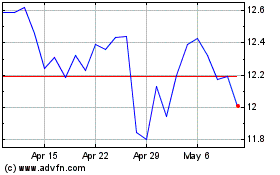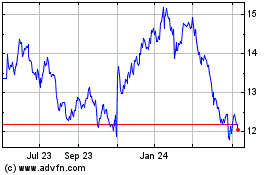KYOCERA Starts R&D on World's First High-Accuracy Bovine Estrus Sensor
April 23 2015 - 8:07AM
Business Wire
Sensor will improve livestock management by
monitoring cow estrus using wireless networks
Kyocera Corporation (NYSE:KYO)(TOKYO:6971) will commence
research and development next month of the world’s first*1 sensing
system that can detect the onset of estrus in cows by combining a
high-accuracy sensor and wireless networks.
Bovine Estrus Detection System
Livestock producers are increasingly adopting information
technology (IT) solutions, including a variety of sensors and
communications networks, to improve efficiency and reduce
costs.
The bovine estrous cycle occurs over 21-day intervals, with
estrus itself lasting only around 12 hours. Accurate detection of
estrus is therefore necessary to facilitate optimum mating
opportunities. For this reason, the estrus cycle is currently
monitored using 24-hour surveillance cameras and acceleration
sensors. However, 24-hour monitoring requires significant labor
resources, and acceleration sensors are not always accurate.
Consequently, avoiding “missed estrus” is a priority among
livestock producers, and an area offering great potential for
improvement.
To address these issues, Kyocera is developing a revolutionary
sensing system to detect indications of estrus in cows by combining
a unique high-accuracy sensor and communications networks. Compared
with existing systems, Kyocera’s system is more accurate in its
high-precision sensing of physical changes in the cow that indicate
estrus. The system sends information on indicators of estrus, as
well as the anticipated end time of the estrus phase, to designated
smartphones and personal computers. This contributes to increased
conception rates while easing the labor burden of 24-hour
monitoring. In addition to enhanced accuracy, the sensor will
provide a greater cost advantage and feature a smaller and lighter
design compared with existing systems. Kyocera will continue its
research and development of this system, aiming for
commercialization in 2017*2.
*1 Combining Kyocera’s original sensing technology and
communication networks creates the world’s first sensing system to
detect indications of bovine estrus without an acceleration sensor.
Based on research by Kyocera (as of April 23, 2015).*2 System
specifications and device designs are current at the time of
announcement and may change without notice.
For more information, please visit:
http://global.kyocera.com/news/2015/0402_rwfh.html
About KYOCERA
Kyocera Corporation (NYSE:KYO)(TOKYO:6971), the parent and
global headquarters of the Kyocera Group, was founded in 1959 as a
producer of fine ceramics (also known as “advanced ceramics”). By
combining these engineered materials with metals and integrating
them with other technologies, Kyocera has become a leading supplier
of electronic components, printers, copiers, solar power generating
systems, mobile phones, semiconductor packages, cutting tools and
industrial ceramics. During the year ended March 31, 2014, the
company’s net sales totaled 1.45 trillion yen (approx. USD14.1
billion). Kyocera appears on the latest listing of the “Top 100
Global Innovators” by Thomson Reuters, and is ranked #531 on Forbes
magazine’s current “Global 2000” listing of the world’s largest
publicly traded companies.
KYOCERA Corporation (Japan)Hina Morioka,
+81-(0)75-604-3416Corporate CommunicationsFax:
+81-(0)75-604-3516webmaster.pressgl@kyocera.jphttp://global.kyocera.com/
Kyocera (PK) (USOTC:KYOCY)
Historical Stock Chart
From Mar 2024 to Apr 2024

Kyocera (PK) (USOTC:KYOCY)
Historical Stock Chart
From Apr 2023 to Apr 2024
